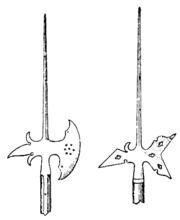Halberd

Halberd
From Wikipedia, the free encyclopedia
Jump to: navigation, search
Swedish halberds from the 16th century
Halberdiers from a modern day reenactor troupe.
This article is about the weapon. For the fictional airship, see Meta Knight#The Halberd
A halberd (or Swiss voulge) is a two-handed pole weapon that came to prominent use during the 14th and 15th centuries. Possibly the word halberd comes from the German words Halm (staff), and Barte (axe). The halberd consists of an axe blade topped with a spike mounted on a long shaft. It always has a hook or thorn on the back side of the axe blade for grappling mounted combatants. It is very similar in many ways to certain forms of voulge.
The halberd was cheap to produce and very versatile in battle. As the halberd was eventually refined, its point was more fully developed to allow it to better deal with spears and pikes (also able to push back approaching horsemen), as was the hook opposite the axe head, which could be used to pull horsemen to the ground.
Additionally, halberds were reinforced with metal rims over the shaft, thus making effective weapons for blocking other weapons like swords. This capability increased its effectiveness in battle, and expert halberdiers were as deadly as any other weapon masters were. It was a halberd, in the hands of a Swiss peasant, which killed the Duke of Burgundy, Charles the Bold, decisively ending the Burgundian Wars -- literally with one stroke.
The Halberd was the primary weapon of the early Swiss armies in the 14th and early 15th centuries. Later on, the Swiss added the pike to better repel knightly attacks and roll over enemy infantry formations, with the halberd, hand-and-a-half sword, or the dagger known as the Schweizerdolch being used for closer combat. The German Landsknechts, who imitated Swiss warfare methods, also used the halberd, supplemented by the pike, but their side arm of choice was the short sword known as the Katzbalger.
As long as pikemen fought other pikemen, the halberd remained a useful supplemental weapon for "push of pike," but when their position became more defensive, to protect the slow-loading arquebusiers and matchlock musketeers from sudden attacks by cavalry, the percentage of halberdiers in the pike units steadily decreased, until the halberd all but disappeared from these formations as a rank-and-file weapon by the middle of the sixteenth century.
The halberd has been used as a court bodyguard weapon for centuries, and is still the ceremonial weapon of the Swiss Guard in the Vatican. The halberd was one of the polearms sometimes carried by lower-ranking officers in European infantry units in the 16th through 18th centuries.
Some of the different types of halberds include:
Hippe
Scorpion
Ji (戟)
A halberd (or Swiss voulge) is a two-handed pole weapon that came to prominent use during the 14th and 15th centuries. Possibly the word halberd comes from the German words Halm (staff), and Barte (axe). The halberd consists of an axe blade topped with a spike mounted on a long shaft. It always has a hook or thorn on the back side of the axe blade for grappling mounted combatants. It is very similar in many ways to certain forms of voulge.
The halberd was cheap to produce and very versatile in battle. As the halberd was eventually refined, its point was more fully developed to allow it to better deal with spears and pikes (also able to push back approaching horsemen), as was the hook opposite the axe head, which could be used to pull horsemen to the ground.
Additionally, halberds were reinforced with metal rims over the shaft, thus making effective weapons for blocking other weapons like swords. This capability increased its effectiveness in battle, and expert halberdiers were as deadly as any other weapon masters were. It was a halberd, in the hands of a Swiss peasant, which killed the Duke of Burgundy, Charles the Bold, decisively ending the Burgundian Wars -- literally with one stroke.
The Halberd was the primary weapon of the early Swiss armies in the 14th and early 15th centuries. Later on, the Swiss added the pike to better repel knightly attacks and roll over enemy infantry formations, with the halberd, hand-and-a-half sword, or the dagger known as the Schweizerdolch being used for closer combat. The German Landsknechts, who imitated Swiss warfare methods, also used the halberd, supplemented by the pike, but their side arm of choice was the short sword known as the Katzbalger.
As long as pikemen fought other pikemen, the halberd remained a useful supplemental weapon for "push of pike," but when their position became more defensive, to protect the slow-loading arquebusiers and matchlock musketeers from sudden attacks by cavalry, the percentage of halberdiers in the pike units steadily decreased, until the halberd all but disappeared from these formations as a rank-and-file weapon by the middle of the sixteenth century.
The halberd has been used as a court bodyguard weapon for centuries, and is still the ceremonial weapon of the Swiss Guard in the Vatican. The halberd was one of the polearms sometimes carried by lower-ranking officers in European infantry units in the 16th through 18th centuries.
Some of the different types of halberds include:
Hippe
Scorpion
Ji (戟)
Other weapons that are sometimes listed as halberds:
Guan Dao
Bisento
Lochaber axe (Jeddart axe)
Naginata
Poleaxe
Bill hook
Dagger-axe
Different sorts of halberds and halberd-like pole weapons in Switzerland
Citizens of Zurich on 1 May 1351 are read the Federal Charter as they swear allegiance to representatives of Uri, Schwyz, Unterwalden and Lucerne. The person on the right side is a scribe reading the text. One of the representatives carries a typical Swiss Halberd of the period depicted (as opposed to the time the image was made, 1515).
Retrieved from "http://en.wikipedia.org/wiki/Halberd"





Comments
Post a Comment